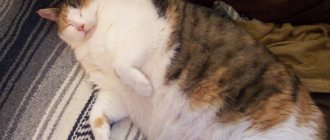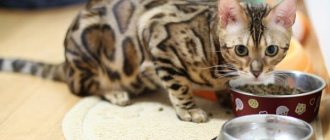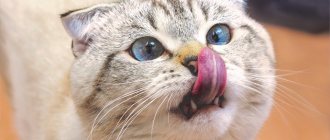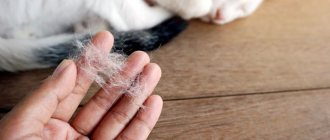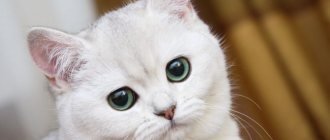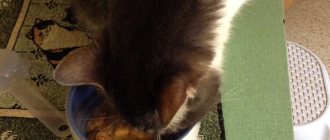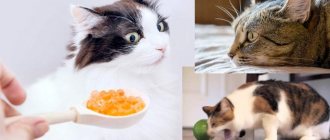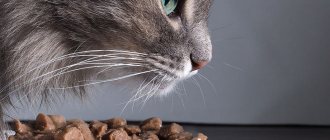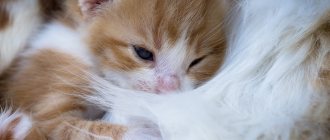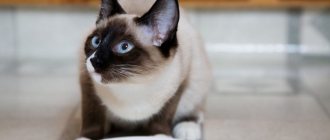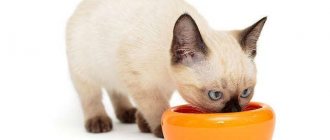Thinness is common to all animals. For example, street cats are rarely well-fed, because... the quality and quantity of food leaves much to be desired. In addition, the constant fight against parasites exhausts the animal. You have to constantly move to survive.
The same cannot be said about pets. But what to do when your pet is rapidly losing weight? Moreover, this is not quite normal seasonal weight loss after “hungry” winter evenings. In most cases, this is the first alarm call for the owner. Below we will consider what cat food (weight gain) to use, how to avoid sudden weight loss or fatness, and what diet to follow?
Best Cat Foods for Weight Gain
When deciding what food to feed a cat to gain weight, the first thing people usually pay attention to is dry food. They are convenient to dose, have a long shelf life, are usually liked by animals and contain a full range of essential substances. The best dry food includes:
- Royal Canin Gastro Intestinal Moderate Calorie
- Hill's Science Plan Perfect Weight
- Acana Orijen SIX FISH
Royal Canin Gastro Intestinal Moderate Calorie
The food contains a daily dose of nutrients necessary for a cat’s health and is often prescribed by veterinarians for weight gain. This product is a special diet for cats with digestive disorders.
The composition includes LIP proteins, which are perfectly absorbed by cats. As well as prebiotics, beet pulp, rice, fish oil. There is an opinion that this food is intended for animals prone to obesity, but in fact this is not the case. A balanced composition will allow your cat to both lose weight and gain weight, depending on what his body needs.
The granules have an attractive taste for animals, which means your pet will eat them with appetite.
Prices:
- 400 g – 381 rubles (190 UAH);
- 2 kg – 1539 rubles (769 UAH).
Buy on Zoopassage.
Hill's Science Plan Perfect Weight
This food is also positioned as a product for cats prone to weight gain, since obesity is much more common than excessive thinness. However, the ingredients are selected in such a way as to correct weight and help cats become healthy and happy for many years.
The food is complete and contains prebiotics, which help normalize the digestion process and improve the absorption of nutrients. The reduced fat content will not allow the liver to be overloaded, so owners see noticeable changes in the appearance and well-being of their pets after a very short period of time.
Prices:
- 250 g – 239 rubles (120 UAH);
- 1.5 kg – 1077 rubles (538 UAH).
Buy on Zoopassage.
Acana Orijen SIX FISH
This is a complete food for cats, the granules of which are 85% fish (sardine, herring, perch, hake, flounder, mackerel). In total, the percentage of protein is 40%. Not only fillets were used, but also entrails and bones, which contain phosphorus, zinc, potassium, calcium, magnesium and other elements necessary for the health and proper functioning of the cat’s body.
Reviews from owners and veterinarians note that the food smells pleasant, and most importantly, the animals like it. Acana Orijen SIX FISH does not contain additional flavorings. An attractive taste is achieved by adding freeze-dried liver.
It is important to know: What should be included in the correct food.
Price categories
All cat food is divided into four price categories:
- Economy is a budget product, in the production of which practically no fresh meat and fish are used. Contains many inexpensive ingredients and chemical additives, many of which can provoke the development of allergies and other diseases;
- premium - natural meat, offal, but to increase shelf life and increase attractiveness for cats, manufacturers use artificial additives, some of which are not very beneficial for the cat’s body;
- superpremium - contains a lot of high-quality meat or fish, but also uses harmful additives (dyes, preservatives, flavor enhancers, flavorings);
- holistic class - up to 90% of meat or fish without preservatives and dyes, so the shelf life is much shorter. Recommended in preparation for exhibitions.
Best Wet Foods for Weight Gain
A diet based on wet food (canned food, spiders) will allow your pet to gain weight much faster than dry food. Owners of underweight animals and veterinarians have seen from their own experience the effectiveness of the following wet foods:
- Royal Canin Recovery
- Royal Canin Convalescence Support Cat
- Applaws Chicken & Duck
Royal Canin Recovery
Sold in 195 gram jars with a convenient key to open, these canned foods are intended for cats and dogs during recovery from illness and intensive care.
One of the main indications for the use of food is lack of body weight, contraindications are acute pancreatitis, hepatic encephalopathy, hyperlipidemia.
The food provides the necessary proteins, fats and carbohydrates for life, and is palatable even for weakened animals. If necessary, Royal Canin Recovery is used for tube feeding, diluted with water.
Price: 195 g – 104 rubles (buy on Zoopassage).
Royal Canin Convalescence Support Cat
This wet food belongs to the dietary category and is intended for cats that are recovering from operations and illnesses, pregnant and lactating cats, as well as extremely thin animals.
The basis of Royal Canin Convalescence Support Cat is protein (pork, poultry, pork and chicken liver). Pet owners note that after starting to regularly consume this food, cats gain weight quite quickly, their immunity is strengthened, they become more active, playful, their stool improves, and the condition of their coat and skin improves.
The best food for picky cats.
Applaws Chicken & Duck
Three quarters of these canned foods consist of meat, which is cooked in its own broth. There are only a few ingredients inside the jar (chicken breast fillet, chicken broth, duck fillet and rice) - such simplicity and transparency of the composition attracts consumers, and it is as close as possible to the natural diet of animals. They note that cats eat these canned foods with great pleasure, fill up with the usual portion, and most importantly, gain weight. If you don’t know what to feed your kitten in order for it to gain weight, then pay attention to wet food. Young animals with milk teeth are not always able to chew dry granules.
Purina
Nestle Purina is a large French company that develops special nutrition for the rapid recovery of pets in case of illness. The Purina line is perfectly balanced and aimed at strengthening the immune system.
Advantages: exclusively natural ingredients: poultry, fish, beef, cereals, enriched with essential microelements and a complex of vitamins. It also contains probiotics and enzymes that have a positive effect on digestion. The manufacturer regularly conducts research in several areas. Experts study the general physiological characteristics and periods of life of animals, nutritional needs for cats of various breeds, and ways to maintain good shape for those animals that have an insufficient level of physical activity. They also pay attention to the constant improvement of the taste of feed. All Purina products are subject to the strictest controls under the guidance of world-class scientists and veterinarians. Judging by the reviews, complete recovery and stable condition are achieved in about a week.
Disadvantages: presence of corn gluten, which is an allergen. Low percentage of vegetables.
Feeding your cat natural food for weight gain
No matter how much the owners would like to fatten up their pets as quickly as possible in order to save them from underweight, under no circumstances should they be given foods rich in fat (sour cream, butter, fatty cottage cheese, pork, etc.).
The liver of an exhausted animal cannot cope with the load.
When feeding natural food, it is necessary to ensure proper nutrition, which means focusing on foods with high energy value and at the same time taking into account the taste preferences of the cat.
Feeding a cat for weight gain should be frequent. Divide the usual amount of food for a standard two-time feeding into 5-6 servings. It is advisable to give food at the same time: this way you will speed up metabolism, metabolic processes will be activated, and weight gain will be more active. The animal must gain weight through muscle, not fat, so the basis of the diet should be protein foods.
For meat, preference should be given to veal and chicken. It is necessary to add fiber to them - bran and oatmeal. It is advisable not to cook them, but simply pour boiling water over them and cover with a lid so that they steam for 10-15 minutes.
Twice a week, the main product can be chicken or beef liver, which needs to be frozen, and before serving, thawed in the refrigerator, and then boiled or scalded with boiling water.
Once a week you can pamper an excessively thin pet with the yolk of a chicken egg or one quail egg. Boiled sea or ocean fish can be given in small quantities (river fish is strictly prohibited). Jellied meat cooked from cartilage will help diversify your diet.
Cottage cheese and unsweetened yogurt can be diluted with low-fat milk, but if dairy products cause diarrhea or are not immediately eaten by the animal, it is better to avoid them altogether. If you don’t have time to think through the diet and cook, but you are against factory-made cat food, try giving baby puree, for example, meat and vegetables.
Make sure that the composition does not contain seasonings, preservatives and flavor enhancers, a minimum of salt (or better without it at all), potatoes and legumes.
At the pet store, you should definitely purchase biologically active supplements with vitamins and microelements, as well as energy supplements (Gimpet Multi Vitamin Extra, Gimpet Gras-Paste, Calo-pet paste, Sanal Topmix, Grau Golden Animal Care, Excel Kittyvite Vitamin Paste, Beaphar Top10).
How to fatten a cat so that it is fat?
Fattening a cat is not difficult. You can give plenty of high-calorie foods. However, this technique does not always work. In areas with hot summers, cats can avoid overheating by reducing their food intake. But in the fall, pets begin to eat intensely and accumulate a thick layer of fat in winter in order to survive the cold.
In such a situation, it is easy to fatten your pet, even without using high-energy food. However, this approach will inevitably lead to obesity and accompanying chronic diseases.
How to switch your pet to dry cat food
You should provide your pet with a balanced diet and stop feeding it from the common table as early as possible. It is not advisable to do this when the cat is pregnant, has recently experienced severe stress (change of owners, place of residence) or is over 12-13 years of age.
You need to transfer your pet to a new type of food within 1-3 weeks, gradually accustoming it.
It is strictly not recommended to train your pet according to the principle “when he gets hungry, he will eat”, completely excluding all other food. Cats are very stubborn, so often attempts to accustom them to new food in this way lead to exhaustion or protests, ranging from loud screams to the appearance of puddles and piles in the wrong places. In addition, a sudden change in diet can lead to digestive problems - the cat’s body simply does not have time to adapt.
It is correct and safe to accustom your pet gradually, offering dry granules in small portions before the usual meal.
Ways to fatten a cat
The digestive system of an emaciated cat is not adapted to digest food. His stomach volume is reduced. Vitamins are required to activate enzymes. A smart solution is to use nutritional supplements. However, for the correct selection, consultation with a veterinarian is necessary. An excess of vitamins can be more dangerous than a deficiency.
Be sure to read:
When to start feeding kittens: how to introduce them, diet, what not to feed, age for first feeding
The second essential component of nutrition is dietary fiber. They are contained in plant components. These are polysaccharides that are not digested by the body's enzymes and serve as a breeding ground for beneficial bacteria in the large intestine. The second useful function of fiber is the adsorption of toxins deposited on the intestinal walls. The third is the stimulation of peristaltic contractions of the intestine and the prevention of constipation.
If antibiotics have been used for a long time to treat a sick animal, there is a high probability that beneficial microbes have died and putrefactive microbes that come with the food develop. Dysbacteriosis occurs, which is accompanied by diarrhea. In such situations, it is necessary to populate the gastrointestinal tract with living bacteria - probiotics.
In an emaciated cat, the volume of the stomach decreases, the activity of digestive enzymes is reduced, and the appetite is weakened. Therefore, at first it is necessary to feed your pet often and in small portions. The transition of a pet from one food to another should be done gradually to avoid feeding stress.
Weight gain on dry food
The easiest way to bring your pet to show condition is to use super premium veterinary food for cats with digestive problems. Such foods are high in calories due to the increased amount of fat. The components of such feeds are vitamins, minerals, probiotics, prebiotics, antioxidants, and dietary fiber. Achievement of optimal weight is determined by the results of weighing, as well as an assessment of fatness.
To prevent obesity, they switch to food to maintain optimal weight. The feed mixture contains an increased amount of dietary fiber, which limits feed consumption, quickly creating a feeling of fullness.
For the production of veterinary food, natural ingredients are used, prepared for feeding by extrusion, containing the components necessary for the cat in optimal proportions. The recommended volume of granules depending on live weight is indicated on the packaging.
Gaining weight on a natural diet
Adherents of a natural diet need to master the skills of preparing a diet, or seek the help of a veterinarian. Cats like raw fish, they willingly drink milk, and greedily pounce on meat, but there is danger in eating such products.
Be sure to read:
How to feed a cat if he doesn’t eat, what to feed a sick cat
It is known that raw foods may contain parasite larvae, pathogenic microbes, and substances that destroy vitamins. Therefore, such products should be boiled. In this case, proteins are denatured and their digestibility decreases. Adult cats do not tolerate lactose well, so milk is contraindicated for them, but fermented milk products are very useful.
Natural products may contain allergens. The problem of mineral and vitamin nutrition, as well as providing the cat’s body with probiotics and prebiotics, will have to be solved independently. Other disadvantages of natural nutrition: food that is not eaten quickly deteriorates. If a cat has gained the required body weight, it is difficult to prevent obesity.
Hill's
Hill's Pet Nutrition has been caring for pets since 1939. Its main task is the development of feed for veterinary use. That is why veterinarians around the world most often recommend Hills's brand food as the most suitable diet for certain diseases.
The food from this manufacturer is premium.
The high-quality Prescription Diet medical line for cats stimulates the functioning of certain internal organs and systems of the body. It helps the animal overcome painful symptoms and gives strength for recovery.
Advantages: excellent recipe with optimal protein content. Hypoallergenic - due to hydrolyzed animal protein and a single source of carbohydrates. The food formula is also supplemented with vitamins, minerals, and essential fatty acids. Sources of carbohydrates in the composition are grains and vegetables. Complete food. This means that no supplements will be required in the animal’s diet to treat it.
Disadvantages: a lot of vegetable protein. The food contains carbohydrates that are poorly processed by the cat's body (for example, corn gluten).
The dangers of excessive fattening of cats and cats
Exhausted cats quickly regain weight and, if food intake is not limited, excess weight develops.
The consequences of obesity are the following diseases:
- liver pathologies;
- diabetes;
- cardiovascular diseases;
- joint diseases;
- hypertonic disease.
Thin cats need increased nutrition. To achieve optimal weight, use dry food or natural products. It is important to prevent obesity, which can cause chronic diseases.
Cat Food, Calories & More - Pet Tips - 2022
When we talk about what we eat as people and how we maintain, gain or lose weight, we talk about calories and typically plan our diets accordingly. However, the calorie counts of different types of cat food are not something that is usually mentioned on the package or discussed usually in any detail, making maintaining your cat's diet rather more of a hit and miss!
However, just like humans, a cat's weight depends on their calories in versus calories out, and understanding this can help you do everything you can, from comparing different cat foods to helping your cat's weight stay stable and knowing how much fun you can feed!
Read on to learn all about cat food, calories, and how many calories cats should eat per day.
What is a calorie?
A calorie is a measurement of energy, and it is literally explained that one calorie is the amount of energy required to raise the temperature of one gram of water by one degree Celsius.
When it comes to discussing diet and the number of calories in a food versus calories burned, a calorie is best explained as the amount of energy within a given food, and the higher the number of calories, the more energy it provides. How much energy (or calories) is optimal for a cat to consume per day will depend on a number of factors, such as the cat's size, age, and activity levels.
Too many calories a day and your cat will gain weight, too few and your cat will lose weight, and if the balance is right, your cat will maintain its healthy weight indefinitely until something changes.
Anorexia
The disease can be called an extreme degree of exhaustion only conditionally.
Anorexia is characterized by severe thinness due to a dulled feeling of hunger. And if in humans the reasons are obvious, then in cats everything is not so simple. Let's list some of them:
- Chemotherapy course. Treatment of malignant tumors is often accompanied by a host of side effects. One of them is a radical refusal to eat. The cat loses interest in food, refuses to play, prefers to hide in secluded places and sleeps a lot.
- Consequences of a major operation . Medicines, including anesthesia, greatly affect the pet’s mood and its orientation in space. They can have a detrimental effect not only on taste preferences, but also completely deprive them of interest in food. Even months later, your cat may still feel the effects of a major surgery.
- Failure of the senses. Usually associated with traumatic brain injuries. This leads to disturbances in neural communication, loss of taste or smell. The cat simply does not understand what is edible and what is not. She can experiment, but in most cases she will get a negative experience. All this leads to the described illness.
Anorexia is very different from simple weight loss. In this case, simple fattening is not enough. In any case, you should contact a veterinarian, get tested and undergo a course of treatment.
Cats and their natural weight maintenance
Cats naturally control their food intake and usually do not eat until they are full. However, cats can, as we all know, suffer from weight problems and obesity, which is usually a consequence of too many calories consumed per day for the cat's activity levels.
This is why pet food for kittens and younger adult cats tends to be higher in calories than food for mature cats; to account for the natural drop in energy levels that cats experience as they get older.
Obviously, maintaining a healthy weight when allowed to graze freely depends not only on the amount of calories in the cat food, but also on how full the cat feels. If a cat doesn't feel full, they will continue to eat, even if they are technically consuming enough calories to support their activity levels. As we all know, the same amount of different types of foods can vary significantly in terms of calories; A 100 calorie portion of vegetables will be much larger than a 100 calorie portion of chocolate, for example, and will be more filling.
Feeding high-calorie foods, especially table scraps and lots of treats, can cause a cat to gain weight, as foods such as these do not prove to be filling with proper balanced meals.
Looking for free pet advice? Click here to join the UKs favorite pet community - PetForums.co.uk
Product comparison table
| Name | Animal age, years | Type of feed | Special Needs |
| Royal Canin | For all ages | dry | For different breeds, sterilized, prone to overeating, hyperactive, picky about smell, taste or aroma |
| PurinaProPlan | Kittens, adults | After sterilization, with sensitive digestion | |
| Grandorf | For sterilized cats, pets | ||
| Sheba | Adults (1-6) | wet | No |
| Gourmet Gold | Kittens, adults | ||
| Royal Canin Instinctive | For sterilized and overweight people | ||
| Superpet | For all ages | dry, wet | Kittens up to 3 months, weakened animals |
| Acana | dry | No | |
| Hill's | dry, wet |
| |
| ProNature | dry | For sterilized, domestic, hairball control | |
| Orijen | For sterilized and overweight people | ||
| AATU | Adults (1-6) | No | |
| Kitekat | dry, wet | No | |
| Friskies | Kittens, adults | For sterilized, domestic, hairball control | |
| Whiskas | For all ages | For sterilized |
How many calories do cats consume per day?
The number of calories your cat consumes per day will, as mentioned, depend on their size, age and activity level. Just like people, different cats have different builds, and some are very small while others are much larger and earlier, so it is important to tailor your cat's feeding routine to suit their own needs.
General calorie intake recommendations for cats vary depending on life stage. Growing kittens can require up to 275 calories per day, and adult cats, depending on their size, build and activity level, typically need anywhere from 200-300 calories per day. If your cat is overweight and is placed on a restricted diet, they will likely be fed between 180-200 calories per day.
How many calories are in cat food and treats?
Cat food packaging usually includes a chart of guidelines to tell you how much of their food to feed per day, calculated based on the cat's size. Once you've determined how many calories your cat consumes per day based on their size, age, and activity level, you can then use the cat food quantity calculation to make a fairly accurate estimate of the calorie count of different servings of prepared cat food.
Cat treats such as Dream and Whiskey temptations contain about two calories per treat, and you should take this into account when planning your cat's daily caloric intake.
